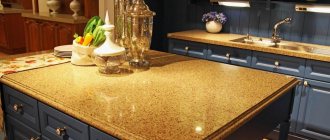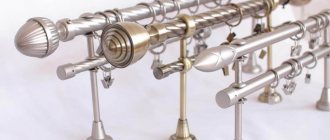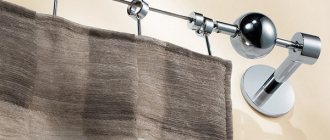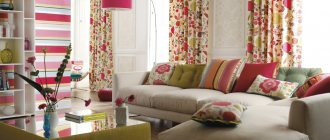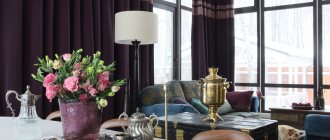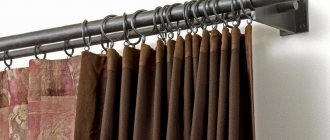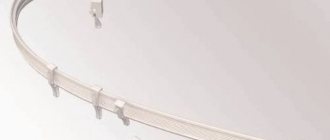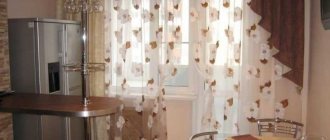What's better?
The main advantage of ceiling cornices is that they:
- cover the entire space from top to bottom;
- can be mounted almost anywhere;
- protect as much as possible from the sun's rays in summer, and from the penetration of cold air in winter;
- When properly mounted, they hide all elements of the cornice.
The downside is a small selection of options.
Advantages of wall views:
- a wide range, which can be clearly seen by looking at photographs of wall cornices in store catalogs;
- the ability to choose a cornice in accordance with the interior style;
- ability to withstand heavy curtains;
- suitable for creating combined compositions.
Experts attribute the disadvantages of the design to the partial leakage of light when completely curtained and the visual reduction of space when creating lush compositions.
However, the disadvantages do not outweigh the advantages, and it is wall curtain rods that are more in demand among buyers.
What cornices are in fashion now?
Modern fashion does not dictate clear conditions, so you can safely choose what you like and not look back at trends. But there are still areas that designers consider the most relevant:
- iron and forging - beautiful minimalist tubular cornices are painted predominantly black and are combined with absolutely all interiors;
- inconspicuousness - the cornice is selected in such a way that it blends with the design and does not in any way distract attention from the decor of the room and curtains (it is better if it is completely invisible);
- figured design - such products are quite expensive, since they belong to atypical cornices - in the form of a tree branch, deer antlers or intertwined grapevines.
Nuances
When choosing to purchase a wall-mounted curtain rod, you should pay attention to the following points:
- appearance of the model;
- color;
- the material from which the structure is made;
- size;
- number of guide elements;
- method of attaching curtains to the cornice;
- types of fastening;
- way to control sliding and curtaining.
Let's consider these points in more detail.
Useful tips for installing and caring for curtains
Regardless of the choice of cornice installation method, you need to consider the following important points:
- Often the dimensions of the cornice do not correspond to individual needs, so it is better to cut off the excess. This needs to be done accurately and carefully - use a miter box, or you can ask to do the work right away in the store if the exact parameters are known.
- If you purchased a round curtain rod, then between the bracket and the tip it is better to place 1 ring or other clamping device that will fix the curtain at one edge - in this case it will not “move” from side to side.
- When installing curtains, it is important to fasten the clips at the same distance to avoid unsightly folds. The interval between the nearest clamps is optimally 10 cm.
- If you use clips, it will be correct to constantly alternate them with rings, since in this case the curtain will be attached stronger and fewer folds will form.
- If the curtains are wider than 2 meters, then an additional central bracket is installed in the center of the cornice - this will make the system much more reliable.
- Curtains often get dirty if you open and close them with your hands, so it is better to purchase a special driver, which is very affordable, and at the same time, thanks to it you will not have to wash the canvas as often.
- You can choose tips or clips separately - they are the ones who create the individual design of the curtains and cornices. The clips look great, in the form of a pattern. corresponding to the pattern of the curtains (stars, waves, zigzags, etc.)
Model types
There are two types of wall cornices - open and “hidden”. The first option is experiencing peak popularity among buyers.
Designers strongly recommend refusing to purchase baguette wall cornices, because... ornate patterns and gilding have gone out of fashion today and have lost relevance even when decorating interiors in a classical style.
Note!
Automatic electric window blinds: review of the best models with photos and descriptions
- Double-row curtain rod, all types: wall, ceiling, metal, plastic. Assembly and installation instructions
- Ceiling hidden curtain rod - do-it-yourself installation and installation rules (110 design photos)
Guides
The interior is decorated with a single-row, double-row or multi-row design - this largely depends on the taste of the apartment owner.
For classic interiors with several curtains, a minimum of a two-row cornice is required. But for an interior decorated in a minimalist or Scandinavian style, one row of guides will be sufficient.
Photo for inspiration
PreviousCurtainsHow to stick tulle on a window using starch
Next
CurtainsChoice of curtains for a window with a balcony door for the hall, living room and bedroom
Curtain control
Along with the old-fashioned method of simply curtaining a window or sliding the curtains with your hands, there are mechanical and electrically driven controls.
Mechanical involves the use of a cord or a cane handle.
The use of remote mechanisms (remotes) is a distinctive feature of electric drive control.
Note!
Plastic curtain rods: ceiling, wall, with hood. Description of all options, as well as photos of new designs
Metal curtain rod: ceiling, double, single-row, double-row. 100 photos in the interior
Bathroom cornice (Bath rods) - how to choose and install it yourself step by step (80 photos)
The choice is up to the buyer.
Color
Until recently, designers recommended using universal colors – gray and brown. Today the trend is black, white and all kinds of shades of yellow. Gold goes well with all light shades, the main thing is to support the precious metal with appropriate accessories.
Gray and brown are not prohibited; experienced interior decorators simply advise avoiding shiny products and curtain rods made of plastic. They significantly “reduce the cost” of the entire interior.
Dimensions
This is one of the most important parameters. The overall impression of the room largely depends on it.
A narrow cornice placed too low will seem to “press down” the entire room, creating a feeling of insufficient air and light.
Fixed high - visually reduces window openings, making them small, lost against the background of the wall.
Rules for determining the dimensions of the cornice
Let's listen to the opinions of experts. They make the following recommendations:
- The width of the window is measured. This is the main length for a baguette.
- An allowance of 25-30 cm on each side is considered universal.
- The cornice should be located approximately ten to fifteen centimeters above the window opening. Naturally, it is necessary to take into account the distance that exists between the window and the ceiling of your room.
- Consider the type of curtain rod you have - runners with hooks should not be located below the top line of the window!
Important! Maintain proportions! In rooms with low ceilings, full-wall curtains will reduce the height of the walls even more!
As for metal structures in the form of a rod, the most important thing here is its (the rod’s) diameter.
In small and medium-sized rooms with ceilings up to three meters, models with a cross-section from sixteen to twenty-five mm are suitable.
In rooms with high ceilings, the rod rod can reach up to 30 millimeters.
Types of metal models
Today there are many models of curtain rods on the market, allowing you to choose a model for any situation. The video in this article will allow you to familiarize yourself with the varieties.
Mounting method
When fixing cornices to the walls, choose one of three options:
- installation directly above the window opening;
- securing the product above the window, but only above part of it;
- installation of cornice between opposite walls.
Important! The installation option depends on the strength of the base, the weight of the curtains being hung, as well as the design of the window and the presence of elements that affect the position of the fabric.
Two types of installation are used:
- Ceiling installation.
This mounting option is excellent for rooms where it is necessary to visually increase its height, as well as in situations where the wall cladding cannot withstand the required load.
Small metal curtain rod for ceiling curtains
- Wall mounting.
Wall mounting is the most commonly used.
Metal wall curtain rods
Design features
- Cornices in the form of a rod.
What is a cornice? It consists of guides (one or more), brackets, tips and devices for securing the material (pictured).
Elements of rod cornice
Such models are also called “tubular”. They are made from pipes of different sections: round, square, rectangular or even twisted. The diameter of the cornice can vary from 1 to 4 cm.
To hang several types of curtains, install a curtain rod with two or three rods in a row.
Double metal curtain rod
To decorate rather ascetic models, all kinds of tips are used to add style and grace to the design.
With the help of such a seemingly insignificant detail, you can add luxury to the design by decorating it with finials made of crystal or Murano glass. And in children's rooms, products depicting various figures or animals significantly diversify the interior.
You can hang tulle or curtains on rods in different ways:
- using rings with clips or hooks;
Rings with clips for securing the blades
- using eyelets;
Curtain with eyelets
- ribbons or ties;
Curtains with ribbons
- on the drawstring.
Fixing the fabric with a drawstring
The guides can be rounded.
Curtains on a rounded rod
Rods, in addition to installation in living spaces, are indispensable for attaching curtains in bathrooms.
Curtain in the bathroom on a tubular cornice
Various design options allow you to decorate window openings that have a non-standard shape.
- String models.
In this case, a metal wire or plastic string is stretched between the metal fasteners. String cornices are completely weightless, suitable for attaching light fabrics made of tulle or, for example, organza. They are suitable for placement in modern interiors or those decorated in minimalist and hi-tech styles.
String version of the cornice
- Profile designs.
Such models are convenient to use for attaching several types of curtains. The most commonly used are one-, two-, and three-row designs. But options with five runners are also used.
- You can successfully place light tulle, thick curtains, and luxurious lambrequins on them. Or hang the same type of canvas, but in different shades, and vary the design of the room depending on your mood.
- It is also convenient to use multi-row cornices for decorating rooms with Japanese curtains, including curtains of different textures.
- To secure the curtains to the profile cornice, hooks are used, a kind of “runners” that move along the runners.
- Profile cornices are flat and wide. Their width can vary from 10 to 30 cm. Thus, products mounted on the ceiling or wall allow you to hang curtains at a certain distance from the window.
- This is convenient if the window sills protrude beyond the window opening. This overhang will allow the curtains to hang freely without touching them.
- Cornices can have a radius or shape necessary for installation on non-standard shaped windows, for example, arched ones. Combined designs are also available.
Combination of tubular and profile guides
Type of metal
- Aluminum.
Both standard and modern flexible models are produced from aluminum, allowing you to place curtains in any place.
Curtain track and hooks for aluminum curtain rods
These products are very convenient in practical terms: they are easy to install, when packaged they are compact, which allows them to be easily transported; if necessary, the length of the curtain rods can be varied.
Flexible aluminum ceiling cornices for curtains
- Steel.
Various models are made from steel, but forged curtain rods are especially impressive. With their help, you can perfectly decorate a room, decorate a window opening even with the simplest curtains. But the price of such products can be quite high.
Elegant forged curtain rod
- Bronze, brass.
Exquisite models are produced from these materials, both in classic styles and with a touch of modernity.
Exclusive model
Material
The most reliable and effective materials for cornices are metal and wood. Structures made from this raw material can withstand heavy curtains. True, wooden and metal cornices are expensive, but they are durable and are unlikely to go out of fashion in the foreseeable future.
Types of cornices according to their configuration
There are 4 main types of products according to their configuration, which are presented on the market as follows:
- round cornices;
- string products;
- profile structures;
- baguette cornices.
Curtains on a round cornice are often used together with blinds
Round products are a rod of the required length for hanging drapes, curtains or tulle. The usual option is a double pipe, although designs with three or four elements also exist. Their appearance, size and style can vary - from ordinary classic to modern. The advantage of this type of curtain rods is their versatility. Both curtains made of thick fabric and light, airy curtains will look great on such products. They are made from either metal or wood.
A forged rose on the cornice will emphasize the exclusivity of the design
Light string cornices will fit perfectly into the modern style of the room. Just keep in mind that such structures can only withstand airy and lightweight fabrics. These can be curtains made of tulle, organza or veil. String curtain rods are a long metal cable from 2 to 5 meters with fastenings on which the curtains themselves are hung. The product is fastened to the selected plane (wall or ceiling) using staples or brackets.
In a minimalist style bedroom, the cornice can be hidden behind the false ceiling
One of the unusual types of cornices is their profile type. Typically, flexible aluminum or plastic is used as the base material. Such curtain rods are used for Roman or Japanese curtains, allowing them to be moved in a special way. In addition, profile structures can be fixed in non-standard ways due to their flexibility, which will be a good option for arched windows.
Metal cornice - a combination of elegance and reliability
Baguette cornices are a wide decorative strip behind which the entire fastening system is hidden. The plank can be made of wood or plastic. The varied decor of baguette cornices allows such designs to fit into any design style. One of the popular decor options is a system of built-in LED lamps that create an atmosphere of comfort and romance in the room.
A wide cornice strip with decorative embossing allows you to place LED lighting
Budget options
Cheaper varieties include cornices made of plastic or MDF. Manufacturers offer a lot of different models in a wide variety of colors. Finding a suitable version to suit your taste and financial capabilities will not be difficult.
Plastic
It should be noted that plastic curtain rods may not withstand the weight of heavy curtains, and in combination with velvet curtains, they will look out of place.
Often, plastic structures are produced as profile cornices, the peculiarity of which is the sliding of the so-called runners (gliders) along the guides.
The curtains are attached to the runners using special hooks and move freely along the entire length of the curtain rod.
Price overview
- Plastic curtain rods can be purchased at a price of 300 rubles per meter.
- A metal cornice will cost the future owner from 1,554 rubles (with a set of components, without ends; for two rods). The forged cornice is a gorgeous thing. Prices for such curtain rods “bite”: from 3,900 rubles (one rod). Aluminum cornice - from 650 rubles.
- Wooden cornices with components cost on average from 500 rubles (single rod) and from 1100 rubles (double rod).
- Baguette cornice without decoration for the amount of 850 rubles. But on average, prices are noticeably higher (for luxurious options you will have to pay from 2500).
- String cornice - from 1000 rubles.
- Prices for profile cornices vary: aluminum models can be purchased at prices starting from 1,160 rubles; cornices for Japanese curtains can be bought for 1,300 rubles (per 1 m).
You can assemble the cornice yourself by purchasing the required number of parts. This will allow you to model the cornice by decorating it with finials or changing the fittings for attaching curtains.
MDF
Cornices made from fine particles are another inexpensive alternative to wooden and metal structures.
Using modern technologies, manufacturers achieve very impressive effects - in appearance, such cornices are not inferior to wood products. However, in this case there is no need to talk about environmental friendliness or durability.
By design
The design determines not only the appearance of the product, but also the complexity and installation features of a particular model. There are several main types.
- Tubular - One of the most common types of cornices, it is a pipe with a round cross-section located on brackets. This rod may have loops or rings, or eyelets. Classic design, widely used.
- String - The peculiarity is that instead of a rod, in this case a steel cable is used, on which the blade is fixed. However, this design has a drawback. Only thin fabrics can be hung on it, since denser and heavier fabrics cause the cable to sag, which looks unsightly.
- Profile - May include 2 or more guides. Double-row curtain rods allow you to place translucent and thin fabric at the same time. This makes it possible to regulate the degree of sunlight in the room.
Fixing curtains
You can secure curtains to the curtain rod in a variety of ways - with clips, hooks, rings, grommets.
In this case, it all depends on which method the apartment owner considers more convenient.
How to secure a cornice and hang curtains
Anyone can install a cornice and hang curtains on their own. The most difficult part of the entire process is installing the curtain rod.
To secure the structure to the wall or ceiling yourself, you will need the following tools:
- building level and metal ruler;
- drill and hammer drill (the latter is necessary if the walls in the room are reinforced concrete);
- screwdriver, screws and screwdriver;
- Screwdriver, screws and dowels;
The first step is to mark and mark the drilling points. Keep in mind that the curtain should lie in smooth and even folds, so an indent of about five centimeters is made from the level of the window sill.
Curtains can be hung on various types of devices. The most commonly used are rings, eyelets, special hooks or clips. Eyelets are practical, but can only be used on round curtain rods and attached to curtains at equal distances from each other.
This way a simple fold is achieved.
If the walls in the room are made of reinforced concrete, you will need a hammer drill.
Do not squeeze the curtains so as not to wrinkle the fabric; do everything neatly and evenly.
How to attach a ceiling cornice to a suspended ceiling
A curtain rod for a stretch ceiling is more difficult to install than attaching it to a concrete ceiling, and requires the use of a wooden board before stretching the ceiling.
Before use, the wood must be sanded and impregnated with an antifungal solution. Mark the position of the beam on the wall or ceiling and secure it using mounting perforated strips.
The ceiling is stretched at the top, and the cornice is attached to the intended location of the beam. If the ceiling is already stretched, then the brackets are screwed to the beam with countersunk screws, to which the cornices are then attached.
When choosing an interior, designers carefully think through every detail. A complete and complete interior depends on the right choice of curtains. The color, fabric and composition of the curtains influence the choice of curtain rod.
Light and medium curtains create a state of weightlessness and let in most of the light. Thick fabrics allow less sunlight to pass through, which can be compensated for by choosing a light-colored fabric.
Choosing a curtain rod will complete the composition. When choosing a ceiling cornice, it is also important to remember the principles of selection and installation of the structure. The difficulty and complexity of installation suggests that it is better to seek help from professionals. Then laconicism and beauty will delight the owner of the apartment!
How to attach a ceiling cornice to a concrete ceiling
Installation of ceiling molding is done after the ceiling has been screeded to ensure proper fit of the ceiling brackets. In this case, you should choose self-tapping screws and dowel-nails of the required size. When marking, the distance to the window should be the same.
If there is a baseboard, cut it off. Drill the marked points, drive nails into the holes and secure the cornice with self-tapping screws (1 piece/50 cm), insert curtain hooks and decorative strips.

